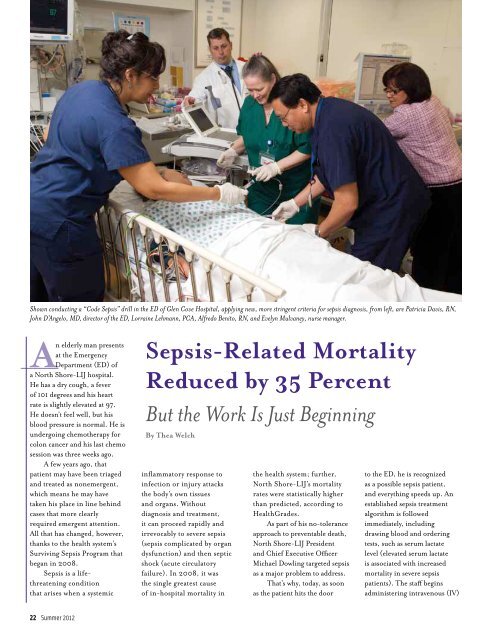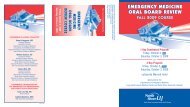Support for Soldiers and Veterans You Gotta Have Heart The Joy of ...
Support for Soldiers and Veterans You Gotta Have Heart The Joy of ...
Support for Soldiers and Veterans You Gotta Have Heart The Joy of ...
Create successful ePaper yourself
Turn your PDF publications into a flip-book with our unique Google optimized e-Paper software.
Shown conducting a “Code Sepsis” drill in the ED <strong>of</strong> Glen Cove Hospital, applying new, more stringent criteria <strong>for</strong> sepsis diagnosis, from left, are Patricia Davis, RN,<br />
John D’Angelo, MD, director <strong>of</strong> the ED, Lorraine Lehmann, PCA, Alfredo Benito, RN, <strong>and</strong> Evelyn Mulvaney, nurse manager.<br />
An elderly man presents<br />
at the Emergency<br />
Department (ED) <strong>of</strong><br />
a North Shore-LIJ hospital.<br />
He has a dry cough, a fever<br />
<strong>of</strong> 101 degrees <strong>and</strong> his heart<br />
rate is slightly elevated at 97.<br />
He doesn’t feel well, but his<br />
blood pressure is normal. He is<br />
undergoing chemotherapy <strong>for</strong><br />
colon cancer <strong>and</strong> his last chemo<br />
session was three weeks ago.<br />
A few years ago, that<br />
patient may have been triaged<br />
<strong>and</strong> treated as nonemergent,<br />
which means he may have<br />
taken his place in line behind<br />
cases that more clearly<br />
required emergent attention.<br />
All that has changed, however,<br />
thanks to the health system’s<br />
Surviving Sepsis Program that<br />
began in 2008.<br />
Sepsis is a lifethreatening<br />
condition<br />
that arises when a systemic<br />
22 Summer 2012<br />
Sepsis-Related Mortality<br />
Reduced by 35 Percent<br />
But the Work Is Just Beginning<br />
By <strong>The</strong>a Welch<br />
inflammatory response to<br />
infection or injury attacks<br />
the body’s own tissues<br />
<strong>and</strong> organs. Without<br />
diagnosis <strong>and</strong> treatment,<br />
it can proceed rapidly <strong>and</strong><br />
irrevocably to severe sepsis<br />
(sepsis complicated by organ<br />
dysfunction) <strong>and</strong> then septic<br />
shock (acute circulatory<br />
failure). In 2008, it was<br />
the single greatest cause<br />
<strong>of</strong> in-hospital mortality in<br />
the health system; further,<br />
North Shore-LIJ’s mortality<br />
rates were statistically higher<br />
than predicted, according to<br />
HealthGrades.<br />
As part <strong>of</strong> his no-tolerance<br />
approach to preventable death,<br />
North Shore-LIJ President<br />
<strong>and</strong> Chief Executive Officer<br />
Michael Dowling targeted sepsis<br />
as a major problem to address.<br />
That’s why, today, as soon<br />
as the patient hits the door<br />
to the ED, he is recognized<br />
as a possible sepsis patient,<br />
<strong>and</strong> everything speeds up. An<br />
established sepsis treatment<br />
algorithm is followed<br />
immediately, including<br />
drawing blood <strong>and</strong> ordering<br />
tests, such as serum lactate<br />
level (elevated serum lactate<br />
is associated with increased<br />
mortality in severe sepsis<br />
patients). <strong>The</strong> staff begins<br />
administering intravenous (IV)




